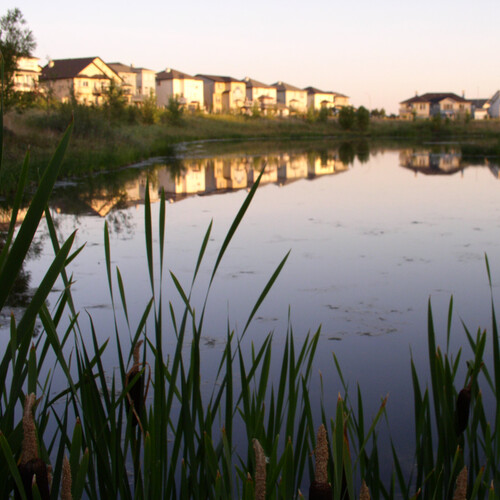Stormwater wetlands are an example of NBS that hold and potentially treat stormwater runoff. These structures work primarily by holding large volumes of runoff from storm events and allowing the water to slowly enter a receiving waterbody such as a lake, stream or river. In the process, water can be partially treated by ultraviolet light, microbial activity, soil binding and sedimentation (particles settling out of the water).
Recommended Practices
Stormwater ponds can be converted to stormwater wetlands by re-contouring the edges of the pond to encourage the establishment of wetland vegetation. Existing shoreline “rip rap” (stones used for erosion control) can be removed or left in place as a base on which to add organic soils. Wetland vegetation can also become established without being planted.
In order for stormwater wetlands to provide water quality treatment, the path length of the water (i.e., the distance that water has to move through the site from inlet to outlet) should be maximized. Basin contouring should be designed to encourage a diversity of wetland plant species. Stormwater wetland design should be done with a drainage engineer and landscape architect.
Water quality measurements should be taken periodically to ensure that water leaving the stormwater wetland is of sufficient quality to enter nearby rivers or natural water bodies without causing harm to aquatic species or other downstream users.
Stormwater wetlands should be used in combination with other stormwater management practices, such as rain gardens (link), bioinfiltration areas and bioswales (link), permeable pavements or minimized impervious surfaces and rainwater capture and use. This ensures greater opportunities for water to infiltrate into the ground and for contaminants to be filtered out of the water before it reaches aquatic ecosystems.
Stormwater credits and performance based design are tools that encourage developers to achieve stormwater runoff targets. Municipalities first determine target stormwater runoff volumes and/or quality from development areas. Developers can then receive credits (tax or otherwise) for meeting these targets through on-site stormwater detention and treatment tools.
Project Considerations
Whether or not stormwater wetlands can offer wildlife habitat value depends on the quality of the water flowing through the site. If there are high levels of contaminants entering the wetland it could become a hazard to wildlife and the developer or municipality may need to implement measures to deter wildlife from using the wetland.
Stormwater wetlands have the potential to be used for recharging groundwater. Underlying groundwater hydrology needs to be understood to ensure the system will perform as intended. Water also needs to be treated to sufficient quality before being allowed to infiltrate into aquifers.
Selective harvesting may also be necessary to prevent the re-release of stored metals and nutrients absorbed by wetland plants.
Stormwater wetlands will continue to filter water entering the system to some degree in winter, due to bacterial activity and physical settling of sediments from the water.
Maintenance of sediment buildup is often necessary in situations where the wetland receives a lot of sand (e.g., from winter road maintenance) or eroded soil. Incorporating a concrete fore bay into the design (i.e., where water enters the wetland) can help facilitate regular sediment removal in these cases.
Public perceptions of stormwater wetlands can be diverse. Engaging residents in a neighbourhood wetland stewardship group can help provide them with an opportunity to learn about and take ownership of the space. Maintaining good communication between the municipality and residents will help landowners develop a better understanding of the wetland’s purpose and multiple values.
The Business Side
There are costs associated with reserving land for stormwater wetlands. However, potential increased revenue from properties adjacent to stormwater wetlands may offer some financial compensation to developers. Stormwater wetlands protect property and infrastructure by reducing the likelihood of flooding. This example of NBS can also lead to reduced water treatment costs of stormwater over the long-term.
The Nature Side
From an environmental perspective, stormwater wetlands provide many benefits. Reduced volumes of water entering streams and rivers during storm events help reduce streambank erosion and downstream sedimentation. Stormwater wetlands can be designed to provide benefits to urban wildlife. There will be differing opinions on the management of some wildlife types (e.g., insects and muskrats) that may be attracted to these sites, but working with residents and sharing information with them can help increase acceptance of all wildlife present. This type of NBS can also be designed to allow for groundwater infiltration however, developers should ensure water quality is sufficient for infiltration in their designs. Adding wetlands to urban and peri-urban areas also allows for an increase in biodiversity and carbon sequestration.
The Community Side
Stormwater wetlands are often designed with walking trails and open spaces for recreation, which benefits residents and promotes physical activity. An increase in green and blue space in a neighbourhood has been shown to have positive impacts on human health (physical, mental and social). Providing opportunities for people to interact with nature in an urban context may help increase their appreciation for the natural world. Children and adults alike can benefit from the many educational opportunities provided by an urban wetland. These include bird watching, pond dipping, and watching beavers and muskrats build shelters. In most cases, a stormwater wetland will also increase the value of adjacent properties.
Alberta Environment and Parks. 2018. Alberta Guide to Wetland Construction in Stormwater Management Facilities. Government of Alberta.
Kadlec., R. H. & Knight, R. L. 1996. Treatment Wetlands. CRC Press.
Primeau, S., Bell, M., Riopel, M., Ewaschuk, E., & Doell, D. 2009. Green Communities Guide: Tools to Help Restore Ecological Processes in Alberta’s Built Environments. Land Stewardship Centre of Canada.
